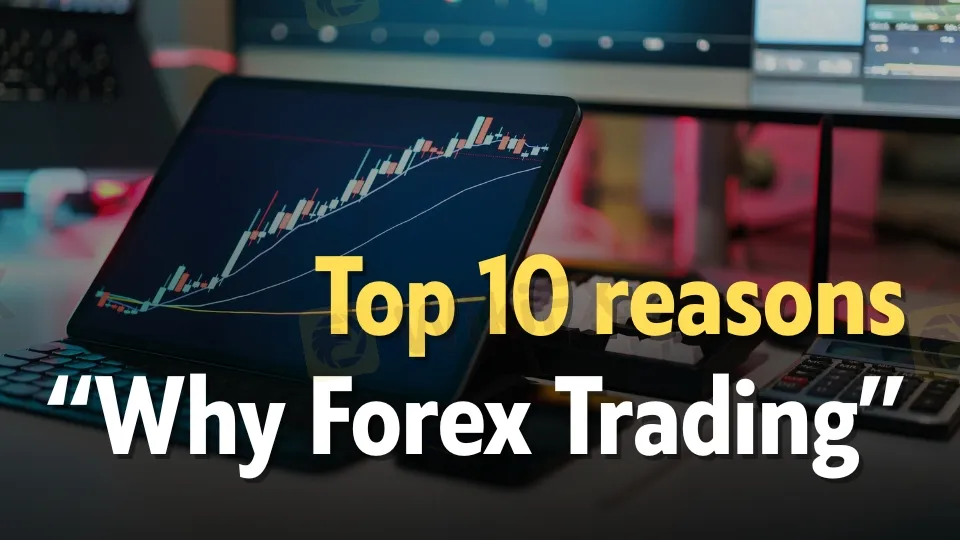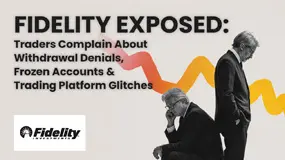简体中文
繁體中文
English
Pусский
日本語
ภาษาไทย
Tiếng Việt
Bahasa Indonesia
Español
हिन्दी
Filippiiniläinen
Français
Deutsch
Português
Türkçe
한국어
العربية
Why Forex Trading? Top 10 Reasons to Start Now
Abstract:Forex trading offers 24/5 access, high liquidity, and strategy flexibility for beginners—learn the top benefits, real risks, and how to start safely in 2025.

Introduction
Forex trading is the global exchange of currencies, operating 24 hours a day, five days a week across major financial centers, and its the most liquid market on earth by daily turnover. According to the BIS Triennial Survey, global OTC foreign exchange turnover reached approximately 9.69.69.6 trillion USD per day in April 2025, with FX swaps being the most traded instrument, highlighting both scale and institutional participation that support pricing and execution quality for retail learners. For beginners, the educational appeal is clear: a continuous market, tight spreads in major pairs, and the ability to practice across time zones with demo environments provide a structured pathway to learn macroeconomics, risk control, and trade evaluation without needing large starting capital. At the same time, leverage can magnify small price moves into outsized gains or losses, so any “start now” framing should be rooted in risk-first learning—position sizing, stop-loss discipline, and a gradual transition from demo to live trading under regulated conditions. This article explains why forex attracts new learners in 2025, where the real advantages are, and how to mitigate the biggest risks so that early experiences build skill rather than volatility-driven setbacks.
Definition and core concepts
- Forex is the over-the-counter market where participants trade currency pairs like EUR/USD and USD/JPY, quoted as one currencys value relative to another in a continuous, decentralized network.
- The market runs 24 hours, five days a week, moving through Asia, Europe, and North America sessions, which gives beginners time flexibility to learn when liquidity and volatility differ by session.
- The BIS reports that spot, swaps, forwards, and options collectively make up the market, with FX swaps accounting for the largest share of turnover and the US dollar on one side of the majority of trades, showing deep institutional participation and benchmarks for new traders to study.
Why it matters in education
- Forex connects directly to macroeconomics: central bank policy, inflation prints, and geopolitical events shift currency valuations, making FX a live laboratory for students to test theories with real-time data.
- The BIS‘s 2025 survey confirms FX’s breadth and depth, which makes it a credible venue to learn order types, execution, and market microstructure while observing how institutions dominate flows and set liquidity conditions.
- Because it is open 24/5, learners can build consistent study routines around session characteristics and practice disciplined trade planning without waiting for limited market hours, boosting the cadence of deliberate practice.

Top 10 reasons to start now
1. 24/5 market access
- FX trades continuously through global sessions Monday to Friday, enabling flexible study schedules for beginners, balancing work or school.
- Session overlaps, such as London–New York, often feature tighter spreads and more movement, which can help learners experience clearer price discovery in liquid times.
2. Deep liquidity and tighter spreads
- With global turnover near 9.69.69.6 trillion USD per day in April 2025, FX offers rapid execution and competitive pricing in major pairs, which is advantageous for cost-conscious beginners.
- Liquidity concentrated in major centers like the UK and US supports consistent fills and robust quote depth during core hours, aiding fair-price learning conditions.
3. Low capital thresholds and demos
- Many brokers offer small minimum deposits and free demo accounts, allowing skills development with virtual funds before risking live capital, which is well-suited to a staged learning plan.
- This accessibility lowers financial barriers to entry for beginners and enables repeated practice of setups, risk controls, and journaling habits.
4. Strategy flexibility for every style
- FX accommodates scalping, day, swing, and position trading, allowing learners to align tactics with time availability and temperament for sustainable learning.
- This variety supports iterative experimentation with clear feedback cycles, from minutes to months, as students refine methods.
5. Potential to trade both directions
- Currencies are always quoted in pairs, so the mechanics of going long one currency and short the other normalize bidirectional trading, which helps beginners understand market neutrality.
- This symmetry means a learning plan can include short setups as naturally as long ones, improving conceptual balance and risk awareness.
6. Transparent, macro-driven pricing
- FX pricing reflects global macro developments across many participants—governments, banks, corporates—reducing single-point manipulation risk relative to thin markets and providing a rich context for study.
- BIS breakdowns of instruments and currencies provide empirical baselines learners can reference while exploring volatility regimes and correlations.
7. Massive, up-to-date data for practice
- Regular BIS releases, plus central bank and market calendars, give beginners authoritative data to back-test ideas and build event-driven playbooks.
- Education-focused broker guides also compile foundational terminology and workflows, assisting with structured onboarding.
8. Portfolio and skills diversification
- Learning FX exposes students to cross-asset thinking—rates, commodities, and equities interlink with currencies—broadening financial literacy and adaptability.
- Because FX responds to global cycles, it can complement equity-centric learning by showing how policy differentials and flows impact trends.
9. Technology and tools for learners
- Platforms offer charts, economic calendars, and order types; combined with demo access, these tools create a safe sandbox for process-oriented training before live deployment.
- Educational libraries from reputable providers help bridge the gap from novice to intermediate through structured lessons and glossaries.
10. A credible, research-backed arena
- The BIS Triennial Survey is a gold-standard reference confirming scale, composition, and geographic distribution of FX trading, reinforcing the markets legitimacy for serious study.
- National central banks, such as the Bank of England, publish jurisdiction-level turnover insights, adding transparency for learners investigating market structure.

Key theories and models
- Interest rate parity and central bank policy: Policy rate differentials often anchor medium-term currency trends; learners can map policy paths to directional hypotheses and risk scenarios using BIS and central bank data.
- Market microstructure and session dynamics: Liquidity, spreads, and volatility vary by session; studying London–New York overlaps versus Asia can inform timing, order choice, and expectations of slippage for beginners.
- Volatility and leverage interaction: Leverage magnifies profit and loss; understanding how small pip moves compound under different leverage settings is foundational to survivability.
Real-world beginner pathways
- Start with demos: Practice trade entries, exits, and journaling across sessions to internalize platform mechanics before risking capital, building a habit of evaluating expectancy and drawdowns.
- Risk-first progression: Transition to small live positions with tight risk per trade and predefined maximum daily loss, focusing on process metrics, not profits, to avoid leverage-driven setbacks.
- Event playbooks: Use authoritative calendars and BIS context to plan for volatility around macro releases, evaluating slippage, spreads, and position sizing under news conditions.
Essential benefits, clearly framed
- Liquidity and pricing: High turnover supports efficient execution and tight spreads in majors, which helps contain trading costs during the learning phase.
- Flexibility and frequency: 24/5 hours and diverse strategies create frequent, lower-stakes practice opportunities that accelerate feedback and skill acquisition.
- Structured education: Abundant reputable resources and demos enable scaffolded learning from vocabulary to advanced tactics without immediate financial pressure.
The risks beginners must manage
- Leverage amplification: Even a 0.5–1% adverse move can severely impact a small, highly leveraged account, leading to margin calls or rapid drawdowns without strict controls.
- Volatility and slippage: Fast markets and low-liquidity sessions can cause worse-than-expected fills; beginners should test different sessions and employ stop-losses sized to volatility.
- Overtrading and psychology: Easy access plus leverage often nudges excessive trade frequency; process goals and pre-trade checklists help curb impulsive entries.
Regulation and safe practice
- Regulators cap retail leverage in many regions to reduce blow-up risk, reinforcing the need to treat leverage as a tool, not a shortcut, especially in early stages.
- Reputable institutions like the BIS and major central banks provide neutral, high-quality data that learners can use to benchmark market conditions and validate assumptions.
How to start responsibly in 2025
- Build fundamentals: Study broker education libraries, master order types, and practice risk metrics like position sizing and maximum adverse excursion in a demo for several weeks.
- Define rules: Limit risk per trade, cap daily loss, and focus on one or two liquid pairs during peak hours to learn with tighter spreads and clearer price action.
- Measure outcomes: Track expectancy, win/loss distribution, and drawdowns; only scale size after demonstrating consistency over a statistically meaningful sample.
Case study: session-based learning
- A beginner focusing on EUR/USD during the London–New York overlap experiences tighter spreads and faster fills, aiding cleaner execution and clearer feedback on strategy edge.
- Incorporating scheduled news events into a playbook allows pre-positioning or standing aside, reducing random entries and improving post-trade analysis quality.
Frequently asked beginner questions
- How much to start? Many brokers allow small deposits and provide demo accounts; the educational priority is skill and risk control, not account size.
- Which pairs? Majors like EUR/USD and USD/JPY often have deep liquidity and narrower spreads, which can help beginners manage costs and reduce noise.
- Is it profitable? FX has real potential, but outcomes hinge on edge development, risk discipline, and avoiding leverage misuse; education-first paths improve odds of durability.
Final insights
Forex trading is a powerful educational pathway thanks to its 24/5 access, deep liquidity, and breadth of strategies, but the very features that make it attractive—frequent movement and available leverage—require a deliberate, risk-first plan to avoid early blow-ups. Anchoring learning in reputable sources such as the BIS and central banks, practicing extensively in demos, and progressing with strict risk rules provides beginners the best chance to develop durable skills and evaluate whether live FX trading suits their goals in 2025 and beyond.

Disclaimer:
The views in this article only represent the author's personal views, and do not constitute investment advice on this platform. This platform does not guarantee the accuracy, completeness and timeliness of the information in the article, and will not be liable for any loss caused by the use of or reliance on the information in the article.
Read more

Fidelity Exposed: Traders Complain About Withdrawal Denials, Frozen Accounts & Platform Glitches
Does Fidelity Investments prevent you from accessing funds despite numerous assurances on your requests? Do you witness an account freeze by the US-based forex broker every time you request withdrawal access? Do you struggle with an unstable trading platform here? Is the slow Fidelity customer service making you face forced liquidation? These issues haunt traders, with many of them voicing their frustration on several broker review platforms such as WikiFX. In this Fidelity review article, we have shared quite a few complaints for you to look at. Read on!

Exposing The Trading Pit: Traders Blame the Broker for Unfair Withdrawal Denials & Account Blocks
Did you receive contradictory emails from The Trading Pit, with one approving payout and another rejecting it, citing trading rule violations? Did you purchase multiple trading accounts but receive a payout on only one of them? Did The Trading Pit prop firm refund you for the remaining accounts without clear reasoning? Did you face account bans despite using limited margins and keeping investment risks to a minimum? These are some raging complaints found under The Trading Pit review. We will share some of these complaints in this article. Take a look.

M&G Review: Traders Report Fund Scams, Misleading Market Info & False Return Promises
Applying for multiple withdrawals at M&G Investments but not getting it into your bank account? Do you see the uncredited withdrawal funds out of your forex trading account on the M&G login? Does the customer support service fail to address this trading issue? Does the misleading market information provided on this forex broker’s trading platform make you lose all your invested capital? Were you lured into investing under the promise of guaranteed forex returns? These issues have become highly common for traders at M&G Investments. In this M&G review article, we have echoed investor sentiments through their complaint screenshots. Take a look!

INZO Broker MT5 Review 2025: A Trader's Guide to Features, Fees and Risks
INZO is a foreign exchange (Forex) and Contracts for Difference (CFD) brokerage company that started working in 2021. The company is registered in Saint Vincent and the Grenadines and regulated offshore. It focuses on serving clients around the world by giving them access to popular trading platforms, especially MetaTrader 5 (MT5) and cTrader. The company offers different types of trading instruments, from currency pairs to cryptocurrencies. It aims to help both new and experienced traders. Read on to know more about it.
WikiFX Broker
Latest News
2 Malaysians Arrested in $1 Million Gold Scam Impersonating Singapore Officials
Is FXPesa Regulated? Real User Reviews & Regulation Check
Fraud Mastermind Zhimin Qian Sentenced to 11 Years for $6.6 Billion Bitcoin Ponzi Scheme
Almahfaza Broker – 2025 Review: Safe or Scam?
Uniglobe Markets Review 2025: A Complete Guide to an Unregulated Broker
INZO Broker No Deposit Bonus: A 2025 Deep Dive into Its Offers and Risks
Exness Broker Expands in South Africa with Cape Town Hub
Global Guide to Finding Forex IBs/Brokers — Share Your Pick and Win Big!
Trump tariffs are helping drive U.S. beef prices to new highs
Consob Targets Political Deepfake “Clone Sites” and Unlicensed Platforms in Latest Enforcement Round
Currency Calculator



